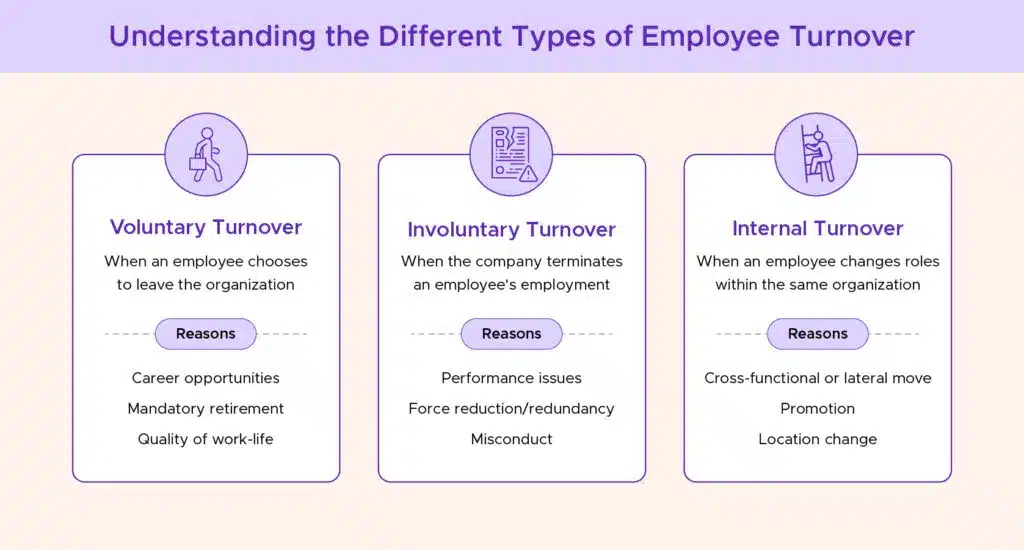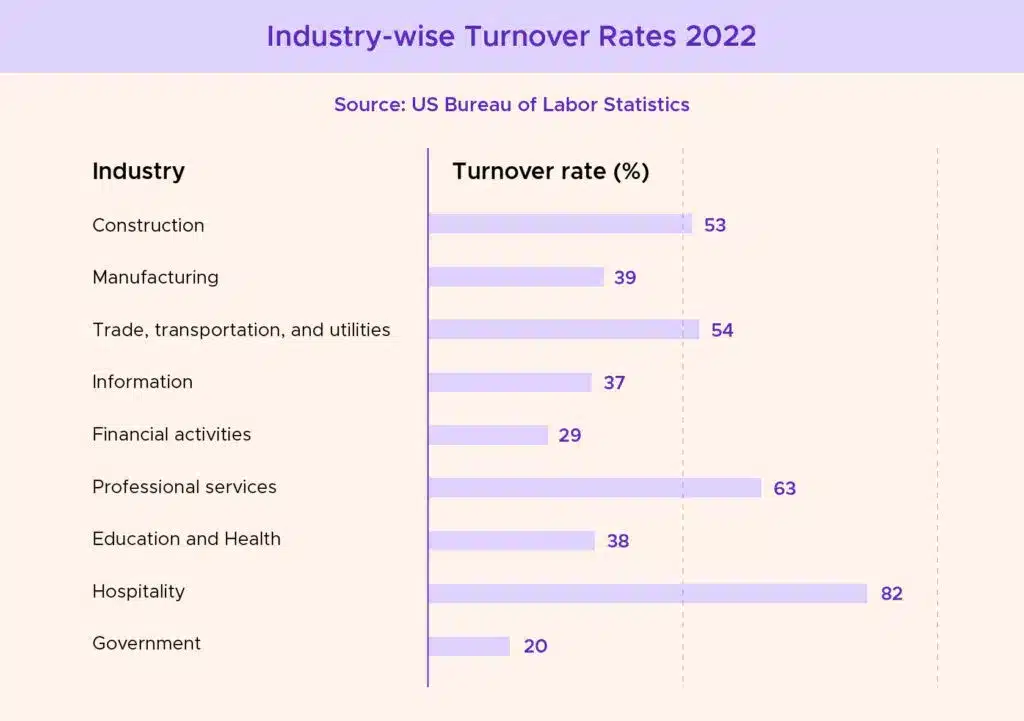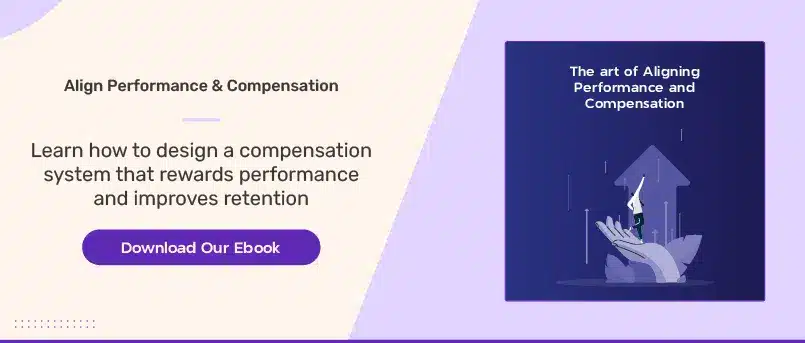In 2021, 47.4 million people quit their jobs in the US.
Every average employee who quits costs you at least half their annual salary to find a replacement.
Constant recruiting and replacing can also get in the way of you reaching your business goals or implementing more ambitious HR strategies.
This article will help you understand, identify, and remedy the increasingly alarming problem of high employee turnover. It will help you make better people decisions.
It will also teach you how to leverage AI, tech, and analytics to build actionable insights that lead to consistently better people decisions.
Let’s get started.

What is Employee Turnover?
Employee turnover measures the number of people leaving your company within a specific period. Unlike attrition, which only measures the number of employees who leave a company voluntarily, turnover measures the number of employees who leave voluntarily, as well as those who are fired or have to retire.
To put it simply, all employees departing from the organization are counted, irrespective of the reason.
Let’s look at an example to understand this better. Say, in your company this year:
- 5 employees resigned
- 2 employees got fired
- 1 employee retired
- 4 new employees were hired
The total turnover is the number of employees who have left, which is = 5 (resigned) + 2 (fired) + 1 (retired) = 8
We’ll use a common formula to calculate employee turnover rate:
Turnover rate formula = (Number of employees who left/ Average number of employees) x 100
Since the turnover calculation takes into account every employee who has left:
- Number of employees who left = 5 (voluntary) + 2 (fired) + 1 (retired) = 8
- Average number of employees = (100 (beginning of year) + 96 (end of year))/2 = 98
Turnover rate = (8/98) x 100 = 8.16%
What is the Impact of Employee Turnover on Companies?
Employee turnover isn’t just a metric you need to track, it has far-reaching consequences for a company. Let’s look at what these are.
Organizational Consequences
Increased financial costs: Every time someone quits, you spend money on recruiting, hiring, and training someone new to replace them. Or you risk being understaffed and over-burdening your current employees, risking losing them too. If the position requires special skills or extensive onboarding, you’ve got even more to lose in terms of time and money.
Disrupted workflows: When employees leave suddenly, you’re left with unfinished projects and overdue deadlines. Even the best planning will not completely avoid the lag that comes with assigning projects to a new employee.
The rest of the team picks up the slack, meaning they have more tasks to complete, giving them less time to actually focus on what they are supposed to do.
The problem worsens if the employees who have left are client-facing. The clients in question may have preferred working with them, and the leaving employees would have known the best way to communicate with them. In this case, you can only expect more disruption as both your client and your remaining employees get used to the new face and working style of your replacements, which we’ll explore more in the next section.
Employee Morale and Engagement
Effects on remaining employees: In the event of your employee leaving voluntarily, your existing employees may start evaluating whether the job or role is right for them. They’ll also wonder what made their colleague decide to leave and go through the harrowing process of looking for a job all over again. Is it the work environment? Was the employee’s annual salary too low? A high employee turnover rate has a negative impact on how your remaining employees view the workplace.
If many employees are leaving voluntarily, the chances of this happening are higher. On the other hand, if many employees are being fired, the employees you retain may start fearing that they will be the next ones to lose their jobs, leading to low morale and job satisfaction.
Cultural implications: Even if you hire new, talented employees to replace the ones who have left, they may not immediately fit in with your company culture, creating a rift in the workplace. This is likely to happen if employees leave unexpectedly, and you do not have as long as needed to go through multiple applications to find the ideal candidate fit for your culture.
Customer Experience
Impact on service quality: If you have a product-based business, new employees may not hold on to the quality that your customers are used to. Your product quality may suffer, and resultantly your customers might leave.
If it is a service-based business, the impact of losing employees is much higher. Take the example of a customer service department in a business that provides enterprise-level solutions to other businesses. The customer service would be client-facing employees who help out with technical issues, software onboarding and answering customer queries. If experienced customer representatives leave, replacing them with new employees will lead to:
- A knowledge gap as new employees do not have the in-depth product knowledge and expertise customers are used to
- Customers missing a familiar point of contact that will disturb the rapport they already have
- Inconsistent service as new hires will take time to meet the usual standards
Brand reputation: Constant employee churn and a change in the quality of service will affect how your customers see you in the long run. In a competitive world where it is so easy to switch to a new product or service, it will get steadily more difficult to get your customers to be patient with you while you train your new employees, or if you struggle to keep up the same productivity with a lower number of employees.
Knowledge and Skills Drain
Loss of institutional knowledge: When experienced employees leave the company, so does their knowledge of clients, processes, and company-specific intel.
You’re losing people who know the ins and outs of their jobs very well and replacing them with employees who will take a long time to get to the same level. This will lead to a drop in the quality and speed of decision-making and problem-solving. Every business runs into issues that experienced employees can smooth out easily — since they have probably dealt with the same issue multiple times. Even when it comes to more strategic business moves, new hires may not have the same dexterity or industry-specific knowledge as a seasoned employee.
Skills gap: If the leaving employees possess specialized skills, the turnover will create a skills gap that will be hard to fill. This goes for any role that requires a niche skill set, like a seasoned sales professional with industry connections or a software engineer who has built the kind of products your business is known for.
Imagine you have a software engineer who has worked with your company for years and comprehensively knows your proprietary software. They’re familiar with each line of code and understand how the whole system works. If this software engineer decides to leave for any reason, it will not be enough to hire just any industry average web engineer. Finding one that will learn quickly enough to not slow development down is nearly impossible.
Long-Term Sustainability
Implications for Future Growth: When you’re constantly losing and replacing employees, focusing on plans that would allow the firm to expand is difficult because you’re forced into a cycle of constantly training and retraining new staff. Can your organization really focus on increasing the number of clients, building new products, or aggressive marketing with high monthly turnover? In cases where turnover rates are especially bad, your company may get a bad reputation in the business world, which makes hiring desirable candidates even more complicated.
Strategic Alignment: When employees leave, particularly when they’re top management or key decision makers, executing strategic plans is threatened. New management comes in with their own vision of what the company could be, and while this may be beneficial, it will steer the business away from the original growth priorities. Turnover rates also take away accumulated expertise, much of which is crucial when it comes to strategic planning, leading to poorer decision-making in the long run.
Types of Workforce Turnover
Not all types of employee turnover are equal. Some turnover is good for the company, while others kinds of high turnover can be damaging.

Voluntary Turnover
This refers to the situation when an employee decides to leave the organization. Employees may resign for a variety of reasons. The main causes are the following:
Career opportunities: Employees will resign if they feel that their current organization does not provide opportunities to learn new skills for career enhancement, professional growth, and better compensation.
Mandatory retirement: This form of voluntary turnover is a natural part of human resource churn and should be addressed through succession planning and knowledge transfer.
Quality of work-life: Employees will resign if they feel that their work is too demanding, and encroaches on their personal time.
Involuntary Turnover
A company terminating an employee’s employment is referred to as involuntary turnover. Reasons for this turnover may include:
Performance Issues: If an employee fails to meet performance expectations, even after receiving proper feedback and coaching from the supervisor, it is justified to terminate the employee’s employment. This is an example of not all turnover being bad, as the leaving employee will be replaced with someone more competent.

Force reduction/redundancy: This happens when it is necessary to reduce the total number of employees due to economic constraints, reorganization, and changes in technological processes. In this case, the type of turnover is forced, and the organization must lay off employees out of redundancy.
Misconduct: This is when the employee is accused of gross misconduct, such as theft, sexual harassment, and breach of the organization’s policy. The employee is resultantly terminated and is another example of not all turnover being bad.
Internal Turnover
When an employee vacates their current position and assumes another role within the same organization, this is referred to as internal turnover. This can be a cross-functional or lateral move, a promotion, or even a location change. This type of mobility is healthy, though sometimes a warning, depending on the concentration of the annual turnover and the transfers in specific areas of the same department.
By analyzing the patterns and trends of turnover, you can identify what you need to work on to build a stable and engaged high-performing workforce.
Looking at benchmarks for normal turnover in your industry? Take a glance at the turnover rates for 2022 according to the US Bureau of Labor Statistics:

Identifying the Root Causes of Turnover
Understanding why your employees are leaving is important. It is the only solution that will work long-term, anything else is just a stop-gap measure that doesn’t fix the original problem. This is more complex than it seems, as the real reasons for people leaving your company are rarely as obvious as they may seem at first.
People analytics lets you analyze vast amounts of data and draw important insights, making it easy to identify the cause of a high turnover rate and take steps to address it.

Employee Engagement
If engagement is low, turnover rates are likely to be high. By analyzing the data from multiple sources regarding employee experience, including engagement surveys and feedback channels (a process that is very easy with Peoplebox), you can pinpoint the cause of turnover.
For example, you can employ AI-powered sentiment analysis to look for trends in the responses to open-ended survey questions. AI will look at the language your employees are using to discover what identifies disengagement and provide relevant feedback to the managers before it is too late.

Workplace Culture
Benefits and high salaries cannot make people stay if your culture is defined by toxic behavior, unreliable management, the absence of recognition, or limited growth opportunities. You can identify these issues with people analytics by examining turnover data from surveys, turnover variability by department or manager, and insights from exit interviews with the help of AI algorithms to discover hidden patterns and correlations.
Compensation and Benefits
If employees feel that what they earn does not correspond to their skills, experience, or market value, they begin to seek other job opportunities. Companies tend to focus on intrinsic rewards like motivation and learning without understanding that these are useless if they’re not paying employees enough. According to SHRM, inadequate pay is a top reason for employees leaving. While high pay can sometimes compensate for poor culture or low work-life balance in a new job, it is rarely the other way around.

Work-life Balance
When employees are overworked and stressed, they leave for other companies that offer more flexible and less taxing conditions. Work is a part of their life, not all of it, and this fact is gaining more publicity in the last couple of years. They need time for personal hobbies and the relationships in their lives, and denying them this is poor management and will lead to them eventually leaving out of frustration.
Developing Corrective Measures to Reduce Employee Turnover
We’ve identified the root causes of staff turnover. You now need a proactive strategy to keep top talent from leaving and ensure lower monthly employee turnover rate. Below are a few critical corrective measures to help you do this:
Conducting Exit Interviews
True to its name, exit interviews give you insight into why employees opt to leave a company. Sentiment analysis tools powered with AI can enhance the effectiveness of these interviews by analyzing text data collected from the employees leaving the organization.
How is this useful to you? You get to quickly and accurately identify the major themes of why people are dissatisfied at your workplace.
Tip: Integrate exit interview data with employee engagement surveys and performance data to create targeted policies to curb turnover.
Investing in Employee Engagement for Reducing Employee Turnover
AI can help detect patterns and the relationships between engagement and various issues, such as recognition, development opportunities, and communication.
With this, you can decide on what to focus on to drive better performance in your companies. Here are a few examples of “quick wins” that can drive engagement in your company within a short period of time.
Start showing your employees you value them:
- Have a formal recognition program reflecting the company culture and values
- Encourage peer-to-peer recognition
- Celebrate successes more often
Make it easy to learn and grow in the workplace
- Conduct skills gap analysis using people analytics
- Create personalized learning paths
- Allow time and dedicate a budget for learning
Tip: Use Peoplebox’s productivity and performance-tracking features to map employee skills and competencies to know what they need help with.
Make it easy to talk to you and bring up problems:
- Set regular communication opportunities
- Ask for feedback and act on it
- Train your managers how to talk and listen
Promote well-being and work-life balance:
- Use people analytics to see well-being trends and risks
- Offer flexible time arrangements
- Provide materials and opportunities for mental health
- Encourage people to go offline and have regular breaks
Help employees socialize:
- Offer regular team-building opportunities
- Encourage cross-functional collaboration and networking
- Celebrate special occasions like birthdays and work anniversaries
Positive Work Culture
To develop and maintain a great culture, you can:
- Utilize employee surveys, feedback sessions, and exit interviews
- Determine deficiencies related to work culture
- Develop specific interventions based on that
Qualitative responses are better at providing a real sense of employee’s opinions about work culture.
Examples of such interventions include leadership training, conflict management workshops, and culture-related initiatives aimed at encouraging respect and collaboration. People analytics will help you do this.
Tip: Create a turnover risk dashboard on Peoplebox by highlighting key metrics that you can drill down to identify flight risks.
Competitive Compensation and Benefits
To attract and retain talent, you need to offer compensation and benefits that are at par with employee expectations and industry standards.
People analytics can be useful in providing employers with tools and mechanisms to compare their compensation and benefits to industry standards.
You can analyze data on the employees’ salaries, bonuses, and benefits in comparison to different roles, experience levels, and regions, to identify whether there are some discrepancies.
Developing Work-Life Balance
People analytics can help understand the effects of work and life balance on employee retention by analyzing their time-tracking records, absence records, and participation in wellness programs. You can spot patterns and correlations to analyze what employee types are in the risk zone.
Identifying the root causes of turnover and implementing retention strategies is easier with a data-driven approach.
Peoplebox: Your Partner in Reducing Employee Turnover
High employee turnover kills productivity and team spirit. Peoplebox is the most integrated OKR, performance, and people analytics software. Our primary goal is to assist companies in keeping their top performers engaged, ultimately improving the bottom line.
Peoplebox goes beyond data – it uses Generative AI to extract actionable insights from all your work tools (think SQL, Jira, Asana) and transforms them into real strategies through its powerful execution platform. The result? Reduced turnover, improved performance, enhanced employee engagement, and data-driven decision-making for strategic talent management.
Ready to retain top talent and reduce turnover? Get in touch with us today!








